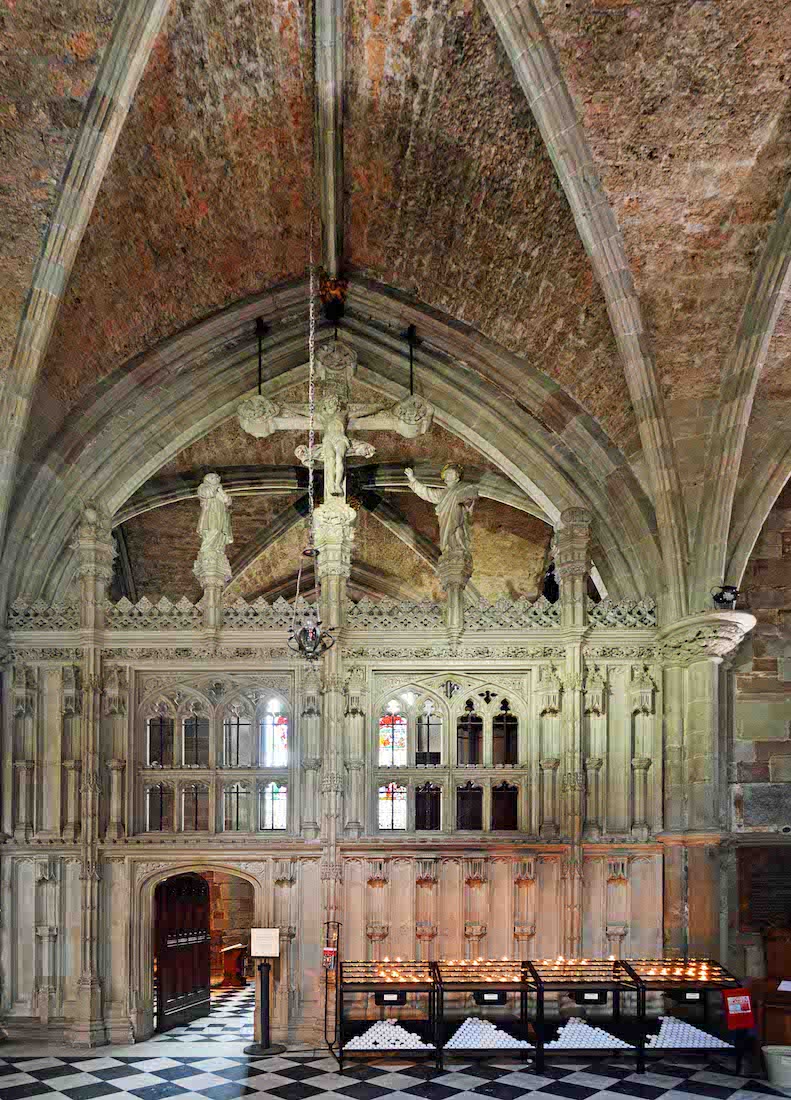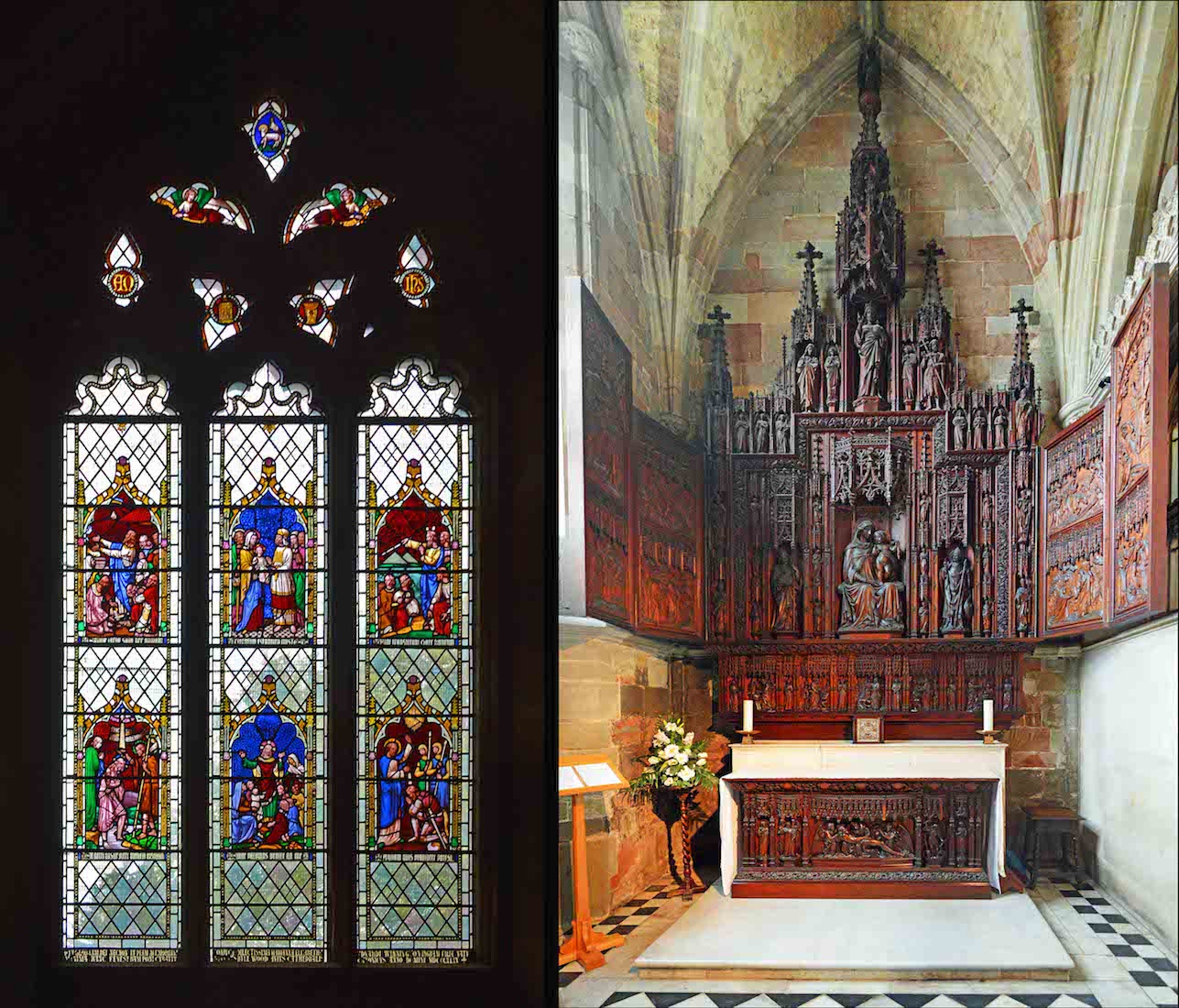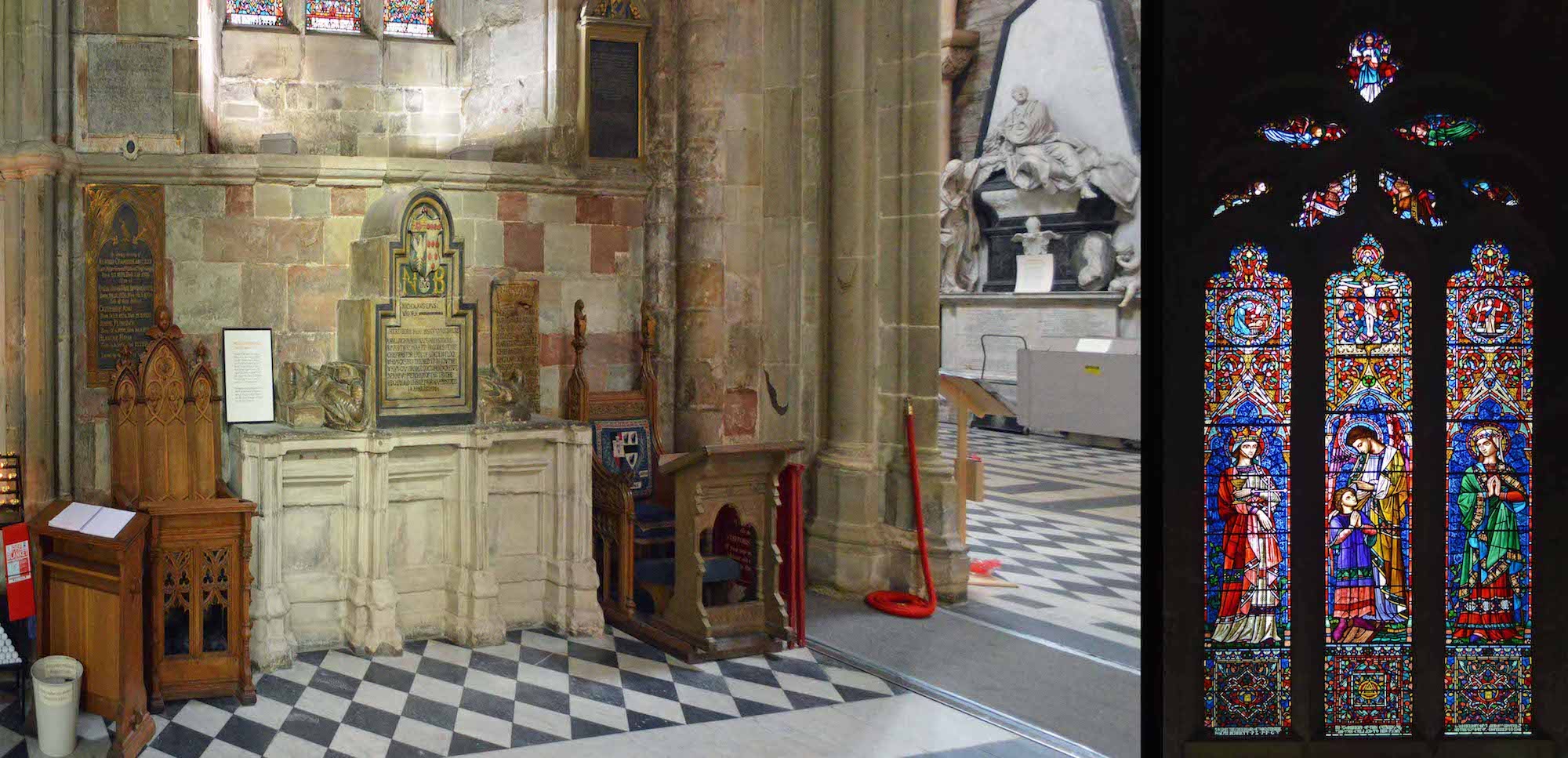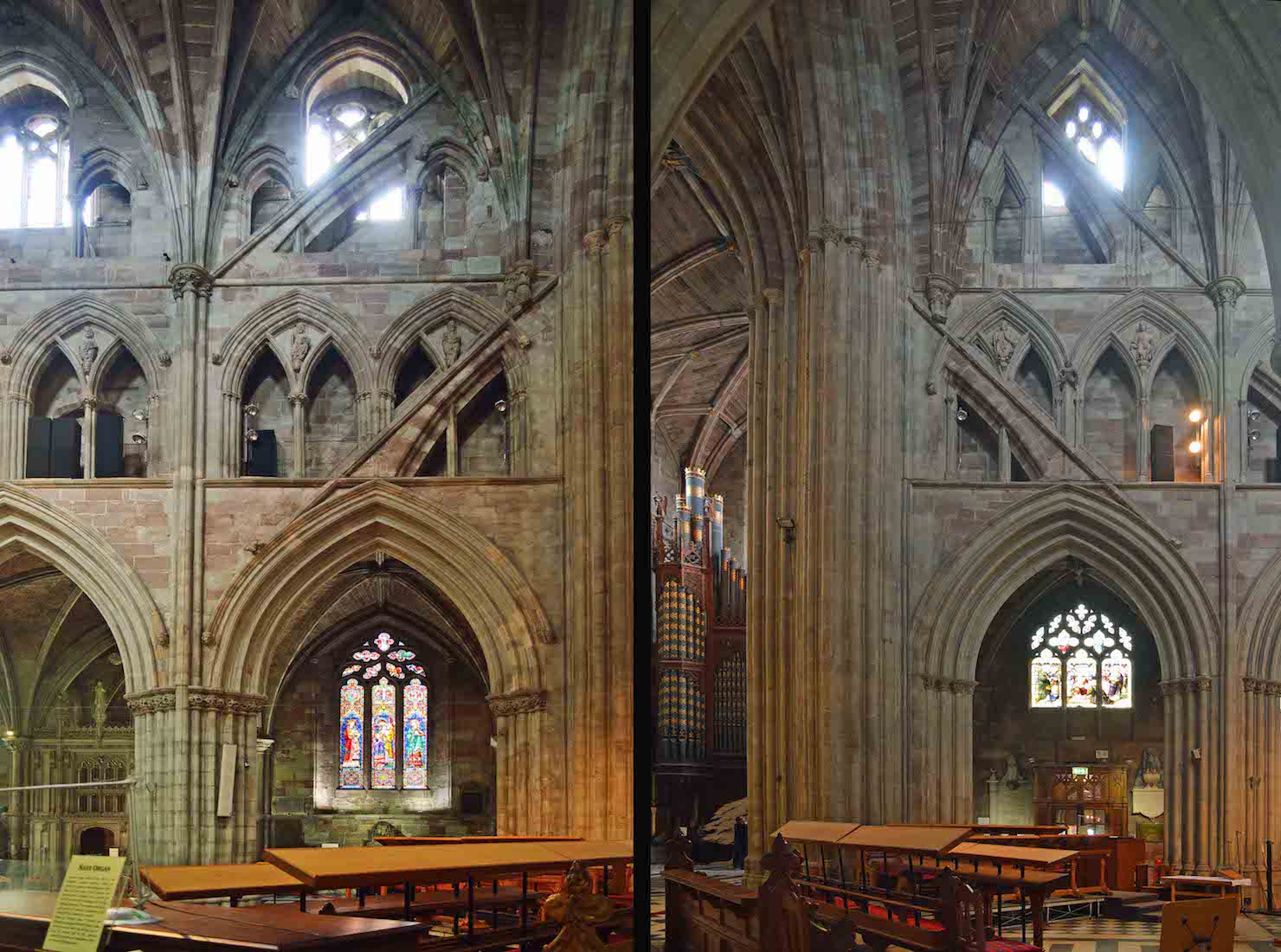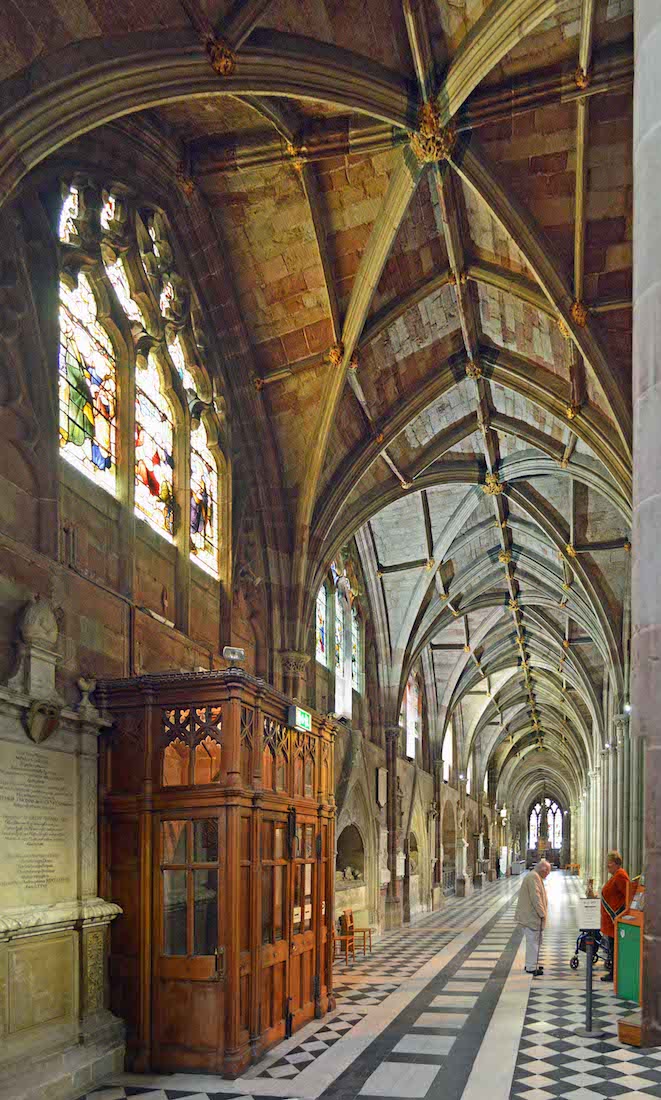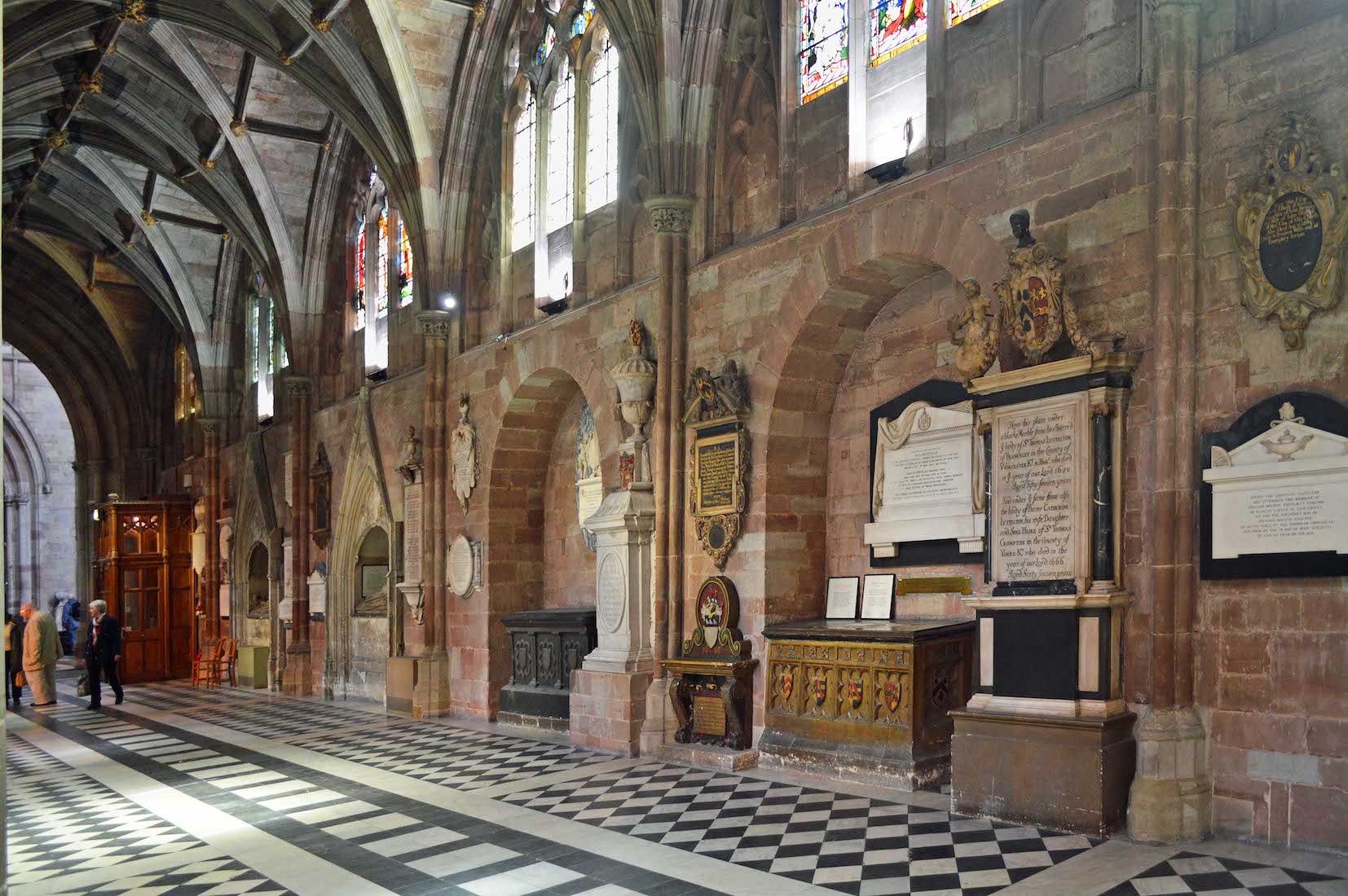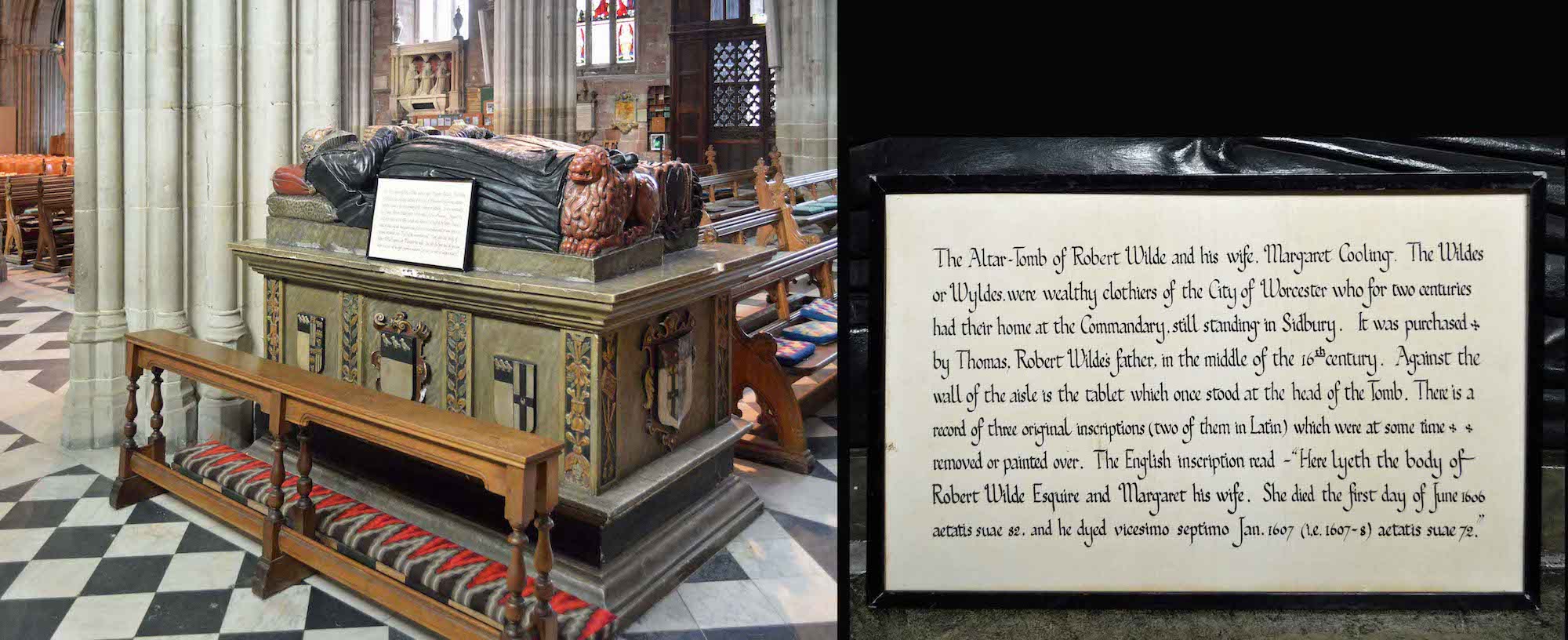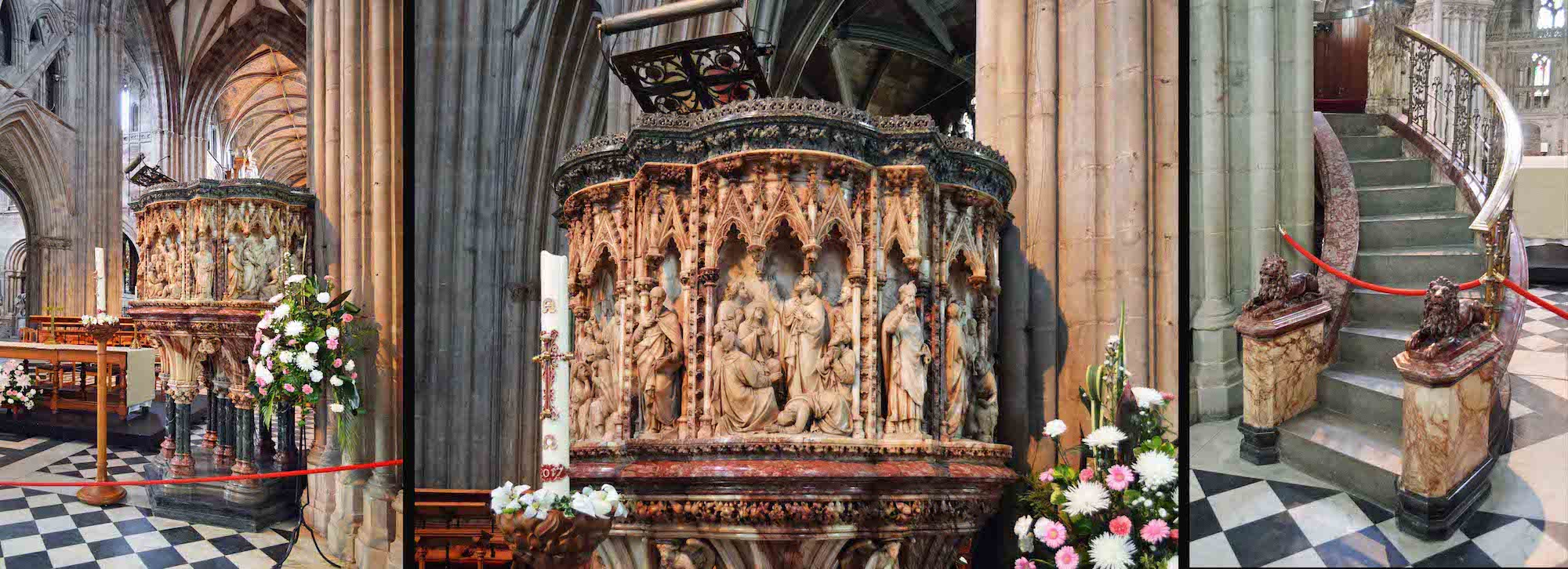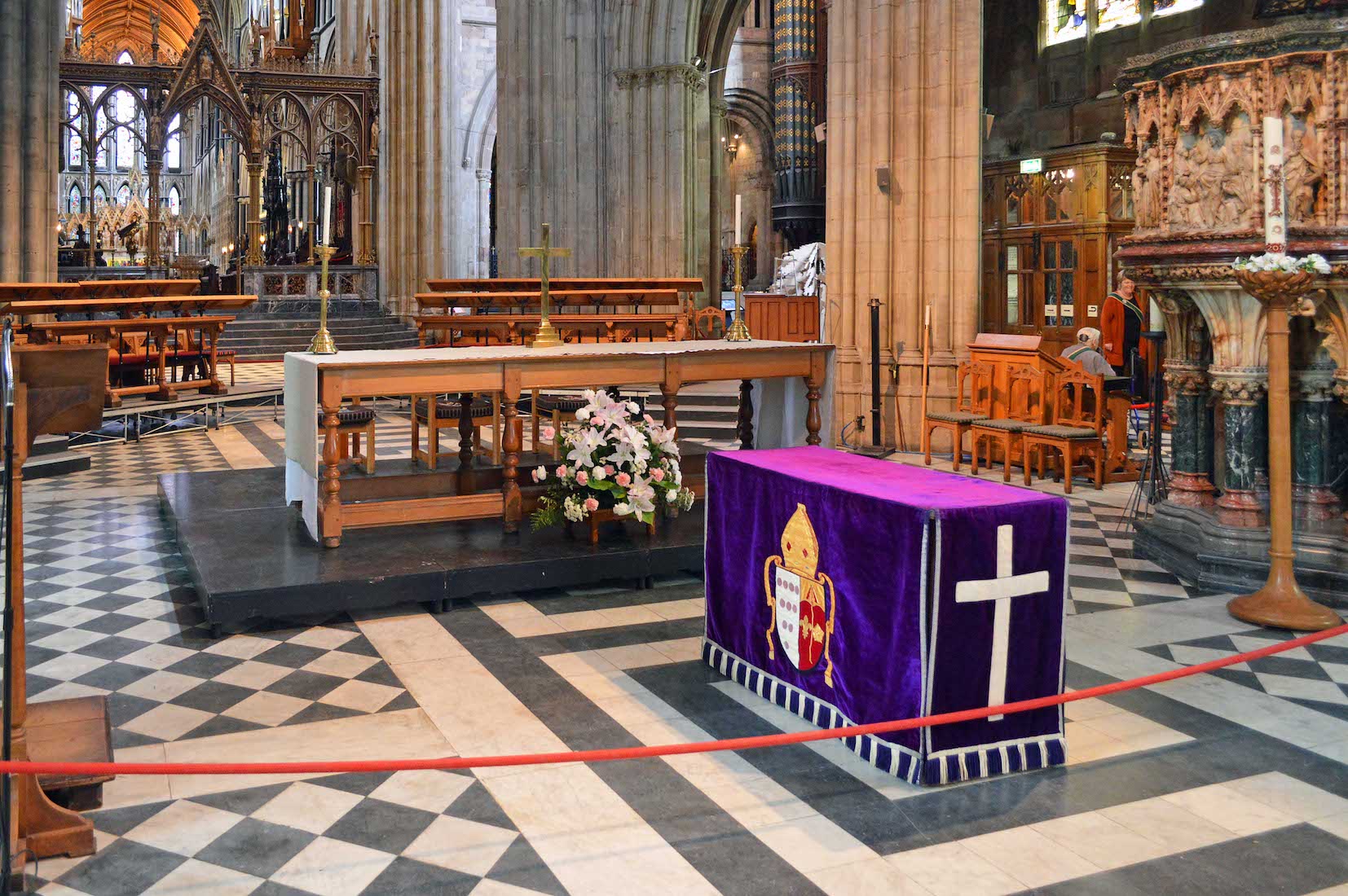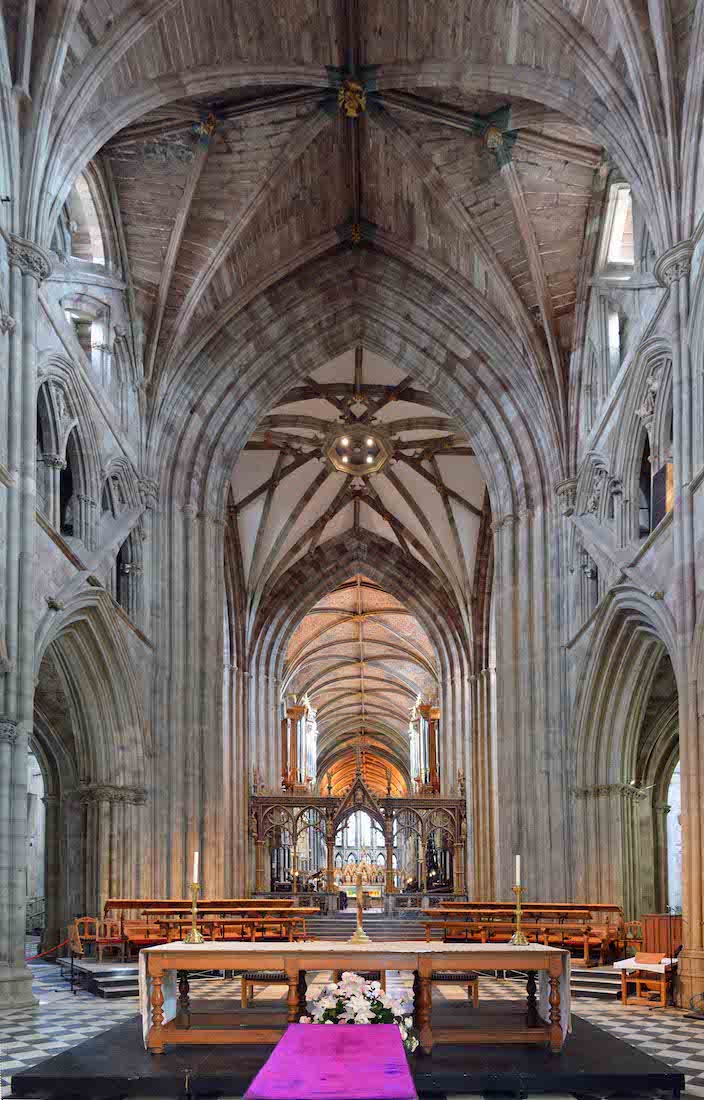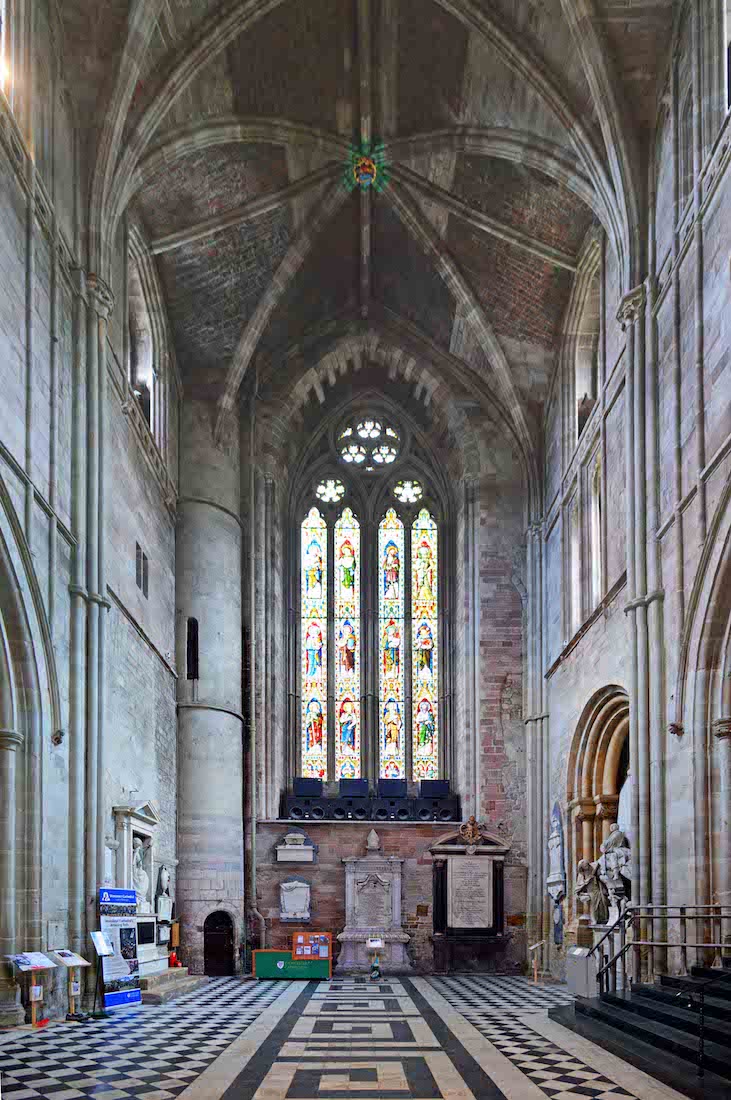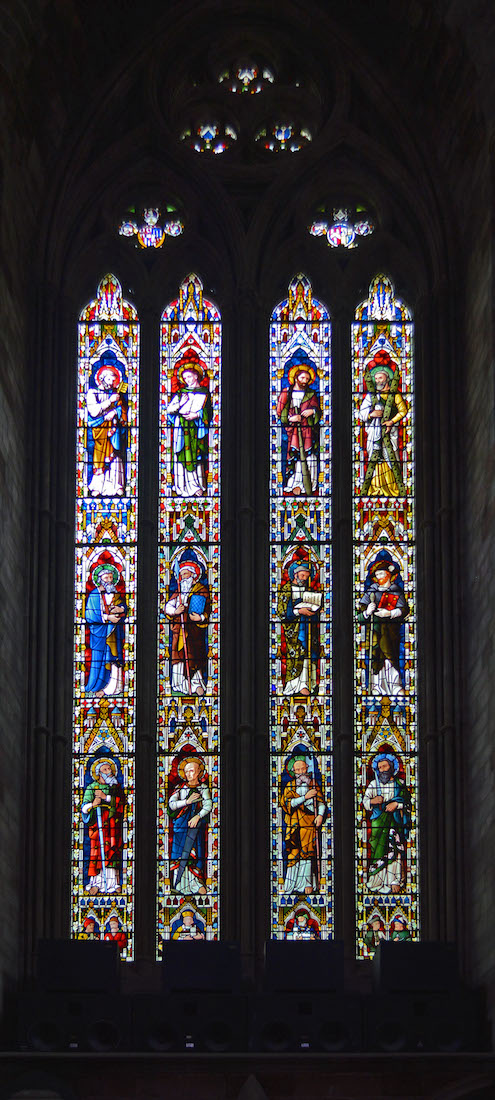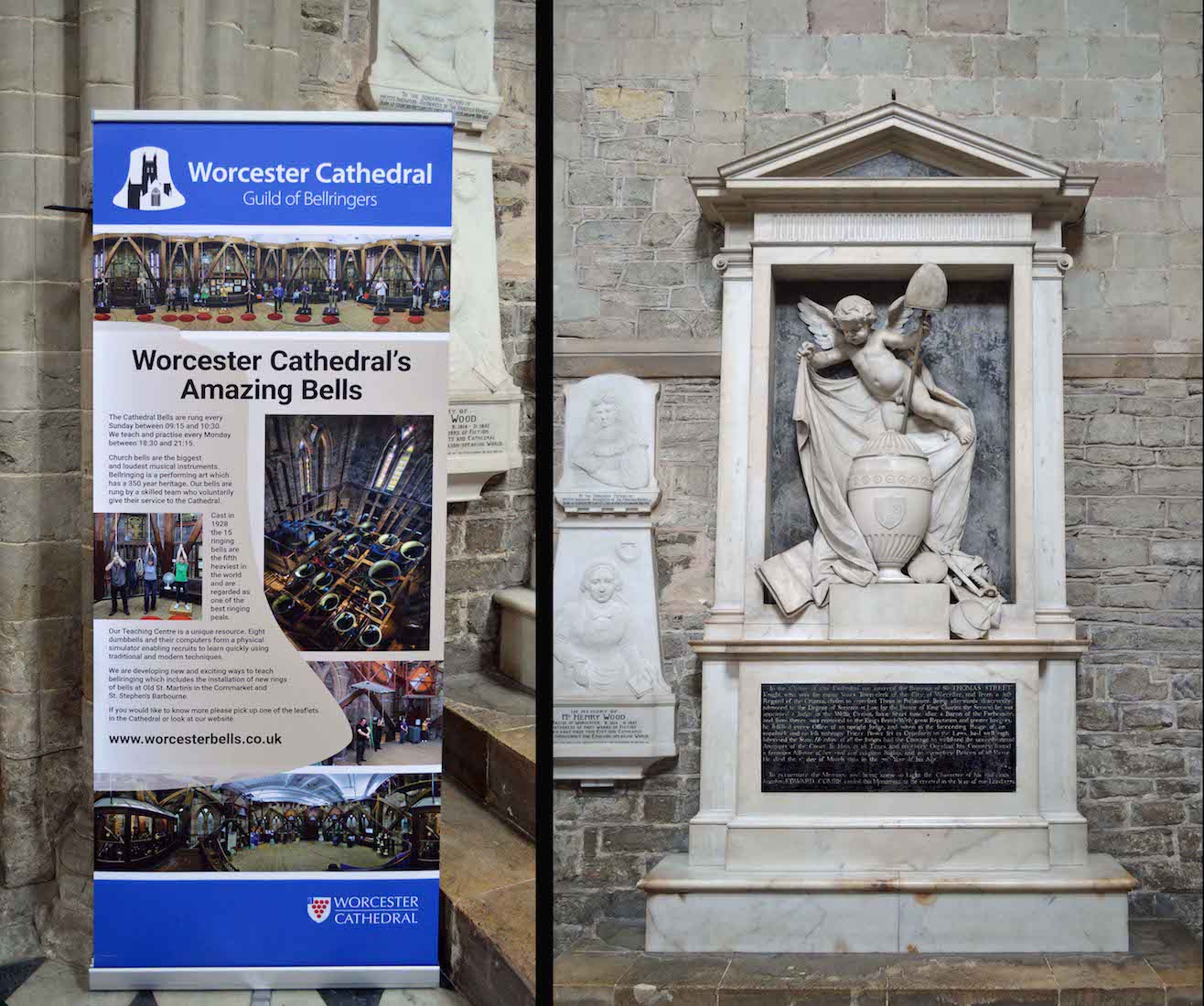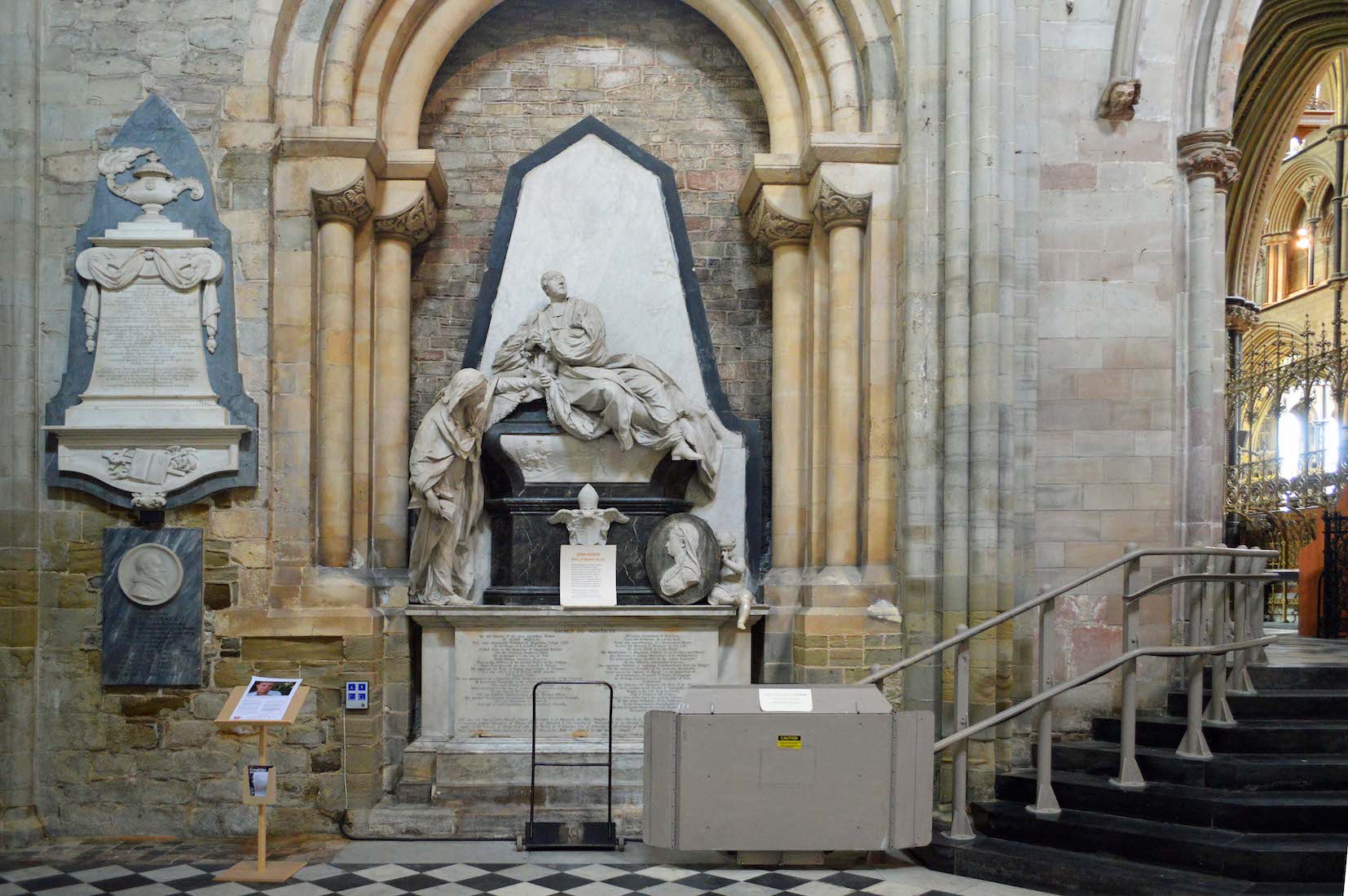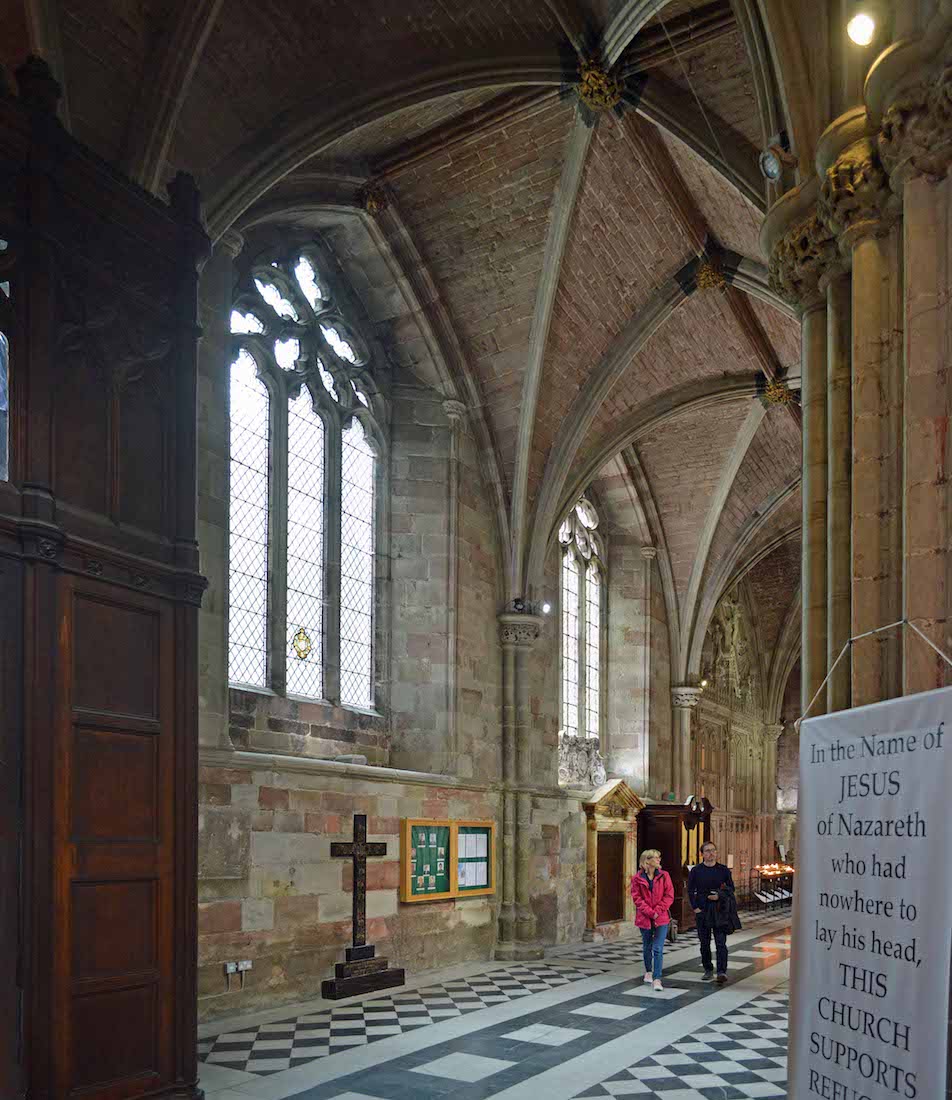
We now investigate the North nave aisle, beginning near the North entry. The sign at right proclaims the Cathedral’s support for refugees in the name of Christ. Then along the outer wall we see a Cross, a vertical tablet which turns out to be a roll of honour, and a small organ. PLAN
42. CROSS, ROLL AND ORGAN
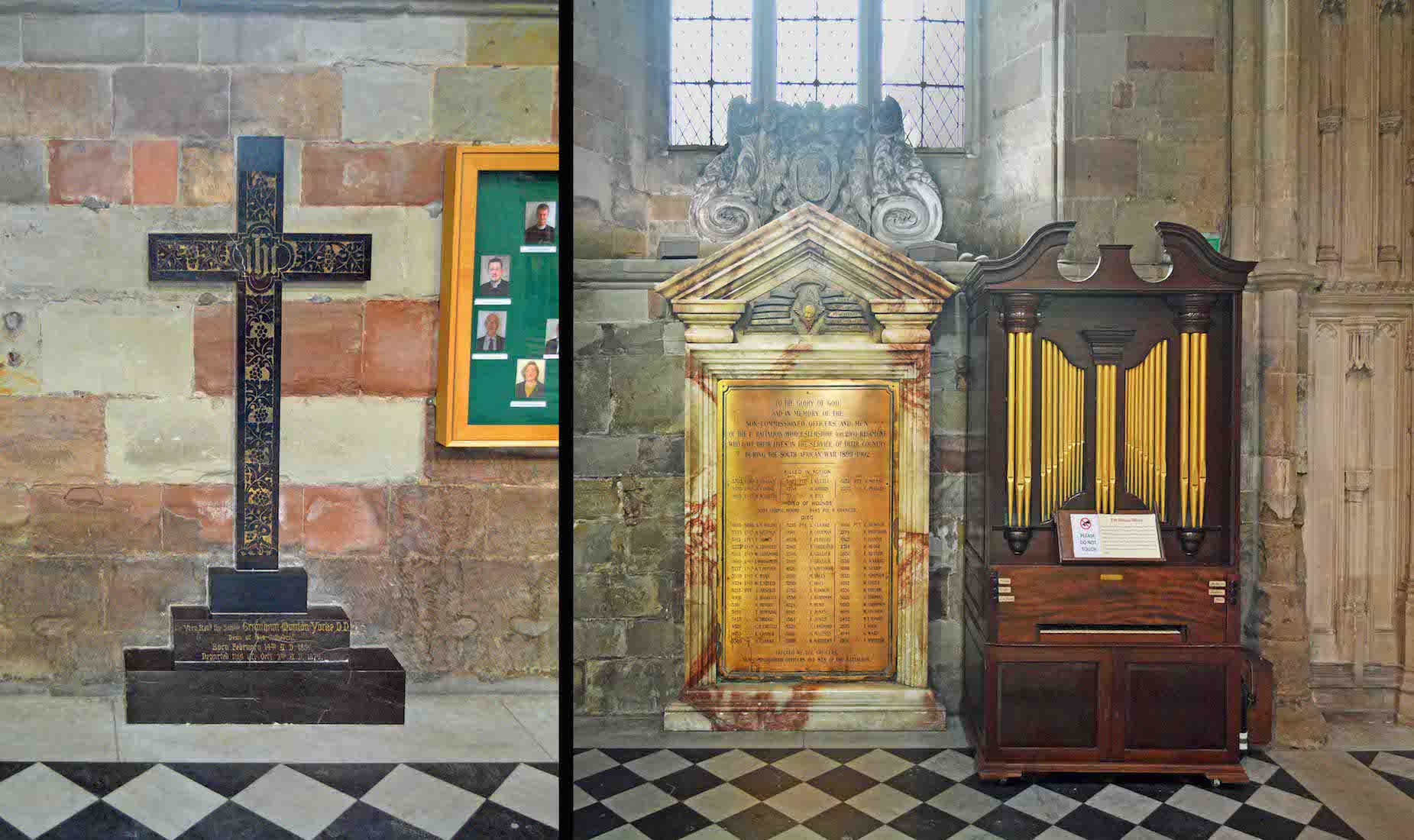
The cross is a memorial to The Very Revd Grantham Munton Yorke DD (1806 – 1879) who was Dean of this Cathedral from 1874 until his death. The Honours Roll lists officers and men from Worcestershire who gave their lives in the South African War (1899 – 1902). The little old chamber organ dating back to 1774 is known as the Handel Organ.
43. ENTRY TO THE JESUS CHAPEL
The small chapel known as The Jesus Chapel extends from the North wall of the nave. Is has an impressive carved façade with three figures at the top: the crucified Christ, his mother Mary, and the disciple John. The facade has four empty niches where further figures could be placed. This chapel is set aside for private prayer.
44. CHAPEL NORTH WINDOW AND ALTAR
The chapel is quite small, with a stained glass window to the North and an altar to the East. Given the name of the Chapel I would like to think we have here six scenes from the life of Jesus. This is true for four panes in which the lead figure has a halo: the baptism, presentation, teaching, and with the centurion. The wonderfully carved altar triptych has the risen Christ and the Madonna and Child as the central figures. .
45. EAST END OF THE NORTH NAVE AISLE
At this end of the North nave aisle we have this odd collection of ecclesiastical furniture and a memorial to Bishop Nicholas Wighorn. He was born and died in Worcester and was buried in 1576. Above the memorial is a stained glass window with three lancets. Unfortunately there is no identification given to the primary figure on each lancet.
46. BEAUCHAMP TOMB
We now retrace our steps to the North door, and the Yorke cross we looked at (#42). Just opposite this cross, and sitting between two supporting columns of the nave is the impressive Beauchamp tomb. Here lie effigies of Sir John Beauchamp (c 1330 – c1389) of Powick and Alcester, and his wife Elizabeth. There are hounds at their feet, and the black swan was part of the family crest.
47. REINFORCEMENTS
Returning to the crossing we note some interesting reinforcing on either side of the nave. The central tower is being supported by diagonal braces at the triforium and clerestory levels. This is well done, but I suspect, not part of the original design!
48. SOUTH AISLE LOOKING WEST
Looking Westward back along the South aisle, we see the baptismal font in the distance. In the vaulting above are a number of gold bosses decorating the joins. The wall at left contains a number of large niches with effigies and memorials. And the stained glass windows are set high in the wall, as they look out above the North cloister walkway. The ‘cupboard’ to the left is the East entrance to the cloisters.
49. SOUTH NAVE AISLE WINDOWS
These windows appear to show (from left): • Mary Magdalene washing the feet of Jesus at the Last Supper; • The Presentation of the baby Jesus / the Nativity / the young Jesus teaching in the Temple; • Angels praising with instrument and song. • Noah / Elisha and Elijah / ? .
50. SOUTH WALL EFFIGIES
These effigies can be found in the South nave wall. At left is the effigy of Bishop Henry Parry who died in 1616. He was Dean of Chester from 1605 to 1607, Bishop of Gloucester from 1607 to 1610 and Bishop of Worcester from 1610 to 1616. The old effigy at right is unidentified, but is thought to be a prior of the 14th century and set in a 13th century recess.
51. ANOTHER VIEW OF THE SOUTH NAVE AISLE
This is a view of the South nave aisle looking towards the East. We notice the clear glass window, and various wall monuments. The golden chest with four coats of arms is a tomb chest memorial for Sir Thomas Lyttleton (1481).
52. ROBERT WILDE TOMB MEMORIAL
Between the supporting nave columns on this side, and symmetrically placed to the Beauchamp tomb, is this tomb memorial for Robert Wilde and his wife Margaret Cooling. The Wildes were wealthy clothiers of the City of Worcester. She died in 1606, and he died six months later.
53. PULPIT
Returning down the South aisle, we come to the elaborately carved pulpit. Sir George Gilbert Scott was employed to finish the restoration of this Cathedral in 1864, twelve years after the work had first begun. He contracted James Forsyth to complete the nave pulpit after his own design, and this was completed in the late 1860s. The carving shows various Biblical figues teaching and preaching.
54. NAVE ALTAR
The nave altar table is placed at the centre of the crossing, and from here the Eucharist is administered Sunday by Sunday. Unusually, in front is a draped table, which may be an allusion to the tomb of King John before the High Altar, but is probably used as a retable during communion.
55. ALTAR TO SANCTUARY
This is a different view, looking across the nave altar to the quire screen and beyond. The octagonal light fitting in the centre of the crossing would be removable, giving access for hoisting building materials up into the central tower.
56. NORTH TRANSEPT
We now turn our attention to the transepts, and firstly the North transept. At first glance we observe the high vaulting, the four-lancet stained glass window, and the black and white patterned floor. A variety of memorials lines the walls. At extreme left is the opening to the North nave aisle, and to the extreme right, the opening to the North quire aisle. Of most interest (?) is the spiral staircase left of the window which gives access up to the central tower.
57. NORTH TRANSEPT WINDOW
This large window of 19th century glass was donated by the Freemasons, and depicts the twelve apostles. In particular, we see St Peter at top left, St Andrew at top right, and St Paul at bottom left.
58. BELLS AND THOMAS STREET MEMORIAL
The notice gives information about the Cathedral’s set of 15 bells which were cast in 1928 and are the fifth heaviest in the world. The memorial to Sir Thomas Street features one of those delightful cherubim! Sir Thomas Street, MP (1625-1696) was an English judge and politician who sat in the House of Commons between 1659 and 1679. He was Mayor of Worcester in 1667.
59. NORTH WALL MEMORIALS
This shows the various monuments and memorials along the North wall of the transept. The two larger memorials remember • Bishop Stillingfleet who died in 1699; the memorial shows two putti heads. • Bishop Fleetwood who died in 1683.
60. EAST WALL MEMORIALS
The large memorial in the framed recess is of Bishop John Hough who died in 1746. The monument is by Roubiliac, and has been called the most important monument in the Cathedral. John Hough was Bishop of Oxford, and then Bishop of Lichfield and Coventry from 1699. He became Bishop of Worcester in 1717. Louis-François Roubiliac (1702 – 1762) was a French sculptor who worked in England, one of the four most prominent sculptors in London working in the rococo style.


